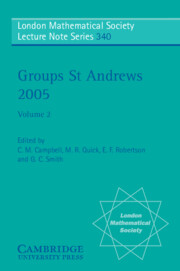Book contents
- Frontmatter
- Contents
- Introduction
- 1 Groups and semigroups: connections and contrasts
- 2 Toward the classification of s-arc transitive graphs
- 3 Non-cancellation group computation for some finitely generated nilpotent groups
- 4 Permutation and quasi-permutation representations of the Chevalley groups
- 5 The shape of solvable groups with odd order
- 6 Embedding in finitely presented lattice-ordered groups: explicit presentations for constructions
- 7 A note on abelian subgroups of p-groups
- 8 On kernel flatness
- 9 On proofs in finitely presented groups
- 10 Computing with 4-Engel groups
- 11 On the size of the commutator subgroup in finite groups
- 12 Groups of infinite matrices
- 13 Triply factorised groups and nearrings
- 14 On the space of cyclic trigonal Riemann surfaces of genus 4
- 15 On simple Kn-groups for n = 5, 6
- 16 Products of Sylow subgroups and the solvable radical
- 17 On commutators in groups
- 18 Inequalities for the Baer invariant of finite groups
- 19 Automorphisms with centralizers of small rank
- 20 2-signalizers and normalizers of Sylow 2-subgroups in finite simple groups
- 21 On properties of abnormal and pronormal subgroups in some infinite groups
- 22 P-localizing group extensions
- 23 On the n-covers of exceptional groups of Lie type
- 24 Positively discriminating groups
- 25 Automorphism groups of some chemical graphs
- 26 On c-normal subgroups of some classes of finite groups
- 27 Fong characters and their fields of values
- 28 Arithmetical properties of finite groups
- 29 On prefrattini subgroups of finite groups: a survey
- 30 Frattini extensions and class field theory
- 31 The nilpotency class of groups with fixed point free automorphisms of prime order
21 - On properties of abnormal and pronormal subgroups in some infinite groups
Published online by Cambridge University Press: 20 April 2010
- Frontmatter
- Contents
- Introduction
- 1 Groups and semigroups: connections and contrasts
- 2 Toward the classification of s-arc transitive graphs
- 3 Non-cancellation group computation for some finitely generated nilpotent groups
- 4 Permutation and quasi-permutation representations of the Chevalley groups
- 5 The shape of solvable groups with odd order
- 6 Embedding in finitely presented lattice-ordered groups: explicit presentations for constructions
- 7 A note on abelian subgroups of p-groups
- 8 On kernel flatness
- 9 On proofs in finitely presented groups
- 10 Computing with 4-Engel groups
- 11 On the size of the commutator subgroup in finite groups
- 12 Groups of infinite matrices
- 13 Triply factorised groups and nearrings
- 14 On the space of cyclic trigonal Riemann surfaces of genus 4
- 15 On simple Kn-groups for n = 5, 6
- 16 Products of Sylow subgroups and the solvable radical
- 17 On commutators in groups
- 18 Inequalities for the Baer invariant of finite groups
- 19 Automorphisms with centralizers of small rank
- 20 2-signalizers and normalizers of Sylow 2-subgroups in finite simple groups
- 21 On properties of abnormal and pronormal subgroups in some infinite groups
- 22 P-localizing group extensions
- 23 On the n-covers of exceptional groups of Lie type
- 24 Positively discriminating groups
- 25 Automorphism groups of some chemical graphs
- 26 On c-normal subgroups of some classes of finite groups
- 27 Fong characters and their fields of values
- 28 Arithmetical properties of finite groups
- 29 On prefrattini subgroups of finite groups: a survey
- 30 Frattini extensions and class field theory
- 31 The nilpotency class of groups with fixed point free automorphisms of prime order
Summary
Abnormal and pronormal subgroups have appeared in the process of investigation of some important subgroups of finite (soluble) groups such as Sylow subgroups, Hall subgroups, system normalizers, and Carter subgroups. Let H be a subgroup of a group G. We recall that a subgroup H is abnormal in G if g ∈ 〈H, Hg〉 for each element g ∈ G; and a subgroup H is pronormal in G if for each element g ∈ G, H and Hg are conjugate in 〈H, Hg〉. Pronormal subgroups have been introduced by P. Hall in his lectures in Cambridge; he also introduced abnormal subgroups in his paper, whereas the term abnormal comes from R. Carter. These subgroups and their generalizations have shown to be very useful in the finite group theory. It appears to be logical to employ such fruitful concepts in infinite groups. However, in some classes of infinite groups these mentioned subgroups gain such properties that they cannot posses in the finite case. For example, it is well-known that every finite p-group has no proper abnormal subgroups. Nevertheless, A. Yu. Olshanskii has constructed a series of impressive examples of infinite finitely generated p-groups saturated with abnormal subgroups. Concretely, for a large enough prime p there exists an infinite p-group G whose all proper subgroups have prime order p [18, Theorem 28.1]. In particular, every proper non-identity subgroup of G is maximal, and being non-normal, is abnormal.
- Type
- Chapter
- Information
- Groups St Andrews 2005 , pp. 597 - 604Publisher: Cambridge University PressPrint publication year: 2007
- 1
- Cited by



